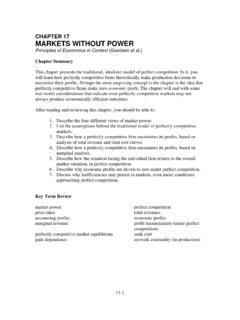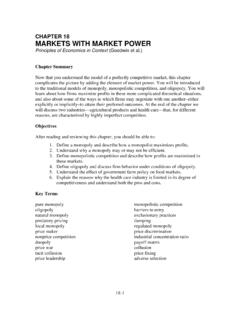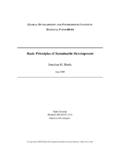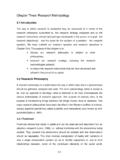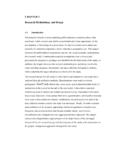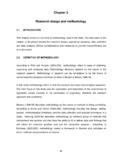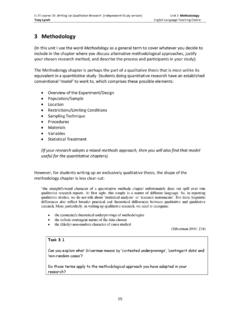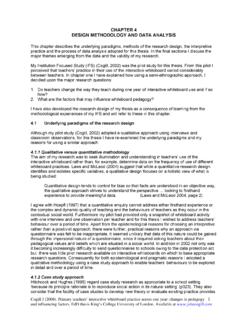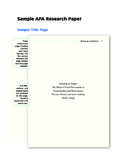Transcription of 7 Economic Behavior and Rationality
1 1457 Economic Behavior and RationalityIn chapter 1, we defined Economic actors, or Economic agents, as people or organizations engaged in any of the four essential Economic activities: production, distribution, consump-tion, and resource maintenance. Economic actors can be individuals, small groups (such as a family or a group of roommates), or large organizations such as a government agency or a multinational corporation. Economics is about how these actors behave and interact as they engage in Economic activities. In this chapter we explore the Behavior of individual Economic actors people. We look at contemporary research on this topic, and, where it seems relevant, compare this with older ec o n o mI c un d e r s t a n dI n G s o f hu m a n mo tI v a tI o n sEconomics is a social science it is about people and about how we organize ourselves to meet our needs and enhance our well-being. Ultimately, all Economic Behavior is human Behavior . Sometimes institutional forces appear to take over (witness the tendency of some bureaucracies to expand over time), but if you look closely at any Economic outcomes, you will find that they are ultimately determined by human decisions or Behavior .
2 Thus economists have traditionally used, as a starting point, some kind of statement about the motivations behind Economic Cl A s s iC Al eC o n o m iC vi e Ws o f hu mA n nA Tu R eIn chapter 5, we mentioned Adam Smith s concept of the invisible hand, according to which people acting in their own self-interest would, through markets, promote the general wel-fare. The concept of the invisible hand has become very famous, but it is often taken out of context to mean that if people only behave with self-interest, they will do what is best for the entire interpretation would have astonished Smith, who, before writing An Inquiry into the Nature and Causes of the Wealth of Nations, had written another long book, The Theory of Moral Sentiments, in which he examined with care how people are motivated. His emphasis there is on the desire of people to have self-respect and the respect of others. He assumes that such respect depends on people acting honorably, justly, and with concern and empathy for others in their community.
3 Smith recognizes that selfish desires play a large role but believes that they will be held in check both by the moral sentiments (the universal desire for self-respect and the respect of others) and also by the fortunate accident by which in many cases (not all!) selfish acts can promote the public interest. 1 Thus Smith s vision of human nature and human motivation was one in which individual self-interest was mixed with more social motives. Rather than starting with Robinson Crusoe, who lived alone on an island, he perceived that the Behavior of any one person always had to be understood within that person s social Ch A P Te R 7 eC o n o m iC Be hA v i oR A n d RA Ti o nA l i T ySmith was followed by other economists, such as the trade theorist David Ricardo and the philosopher/economist John Stuart Mill. They held similarly complex views of human nature and motivations. In 1890 Alfred Marshall tried to codify these ideas in a very influential text called Principles of Economics, which was published in eight editions, the last published in 1920.
4 Marshall viewed the motives of human actors in an optimistic light including those of economists, whom he assumed were motivated by a desire to improve the human condition. He specifically focused on the reduction of poverty so as to allow people to develop their higher moral and intellectual faculties, rather than being condemned to lives of desperate effort for simple Th e ne oC l A s s iC Al mo d e lIn the twentieth century, the approach that came to dominate economics was known as the neoclassical model. This approach took a narrower view of human motivations. The basic neoclassical or traditional model builds a simplified story about Economic life by assuming that there are only two main types of Economic actors and by making simplifying assump-tions about how these two types of actors behave and interact. The two basic sets of actors in this model are firms, which are assumed to maximize their profits from producing and selling goods and services, and households, which are assumed to maximize their utility (or satisfaction) from consuming goods and services.
5 The two kinds of agents are assumed to interact in perfectly competitive markets (the subject of chapter 16). Given some additional assumptions, explored later in this book, the model can be elegantly expressed in figures, equations, and benefits can be gained from looking at Economic Behavior in this way. The assumptions reduce the actual (very complicated) economy to something that is much more limited but also easier to analyze. The traditional model is particularly well suited for analyzing the determination of prices, the volume of trade, and efficiency issues in certain neoclassical model was introduced to generations of students in 1948 with the publication of Paul Samuelson s textbook Economics: An Introductory Analysis, which went on to become the best-selling economics text ever. Samuelson s text promoted the idea that economics should be value free ( , it should be developed without reference to any human goals or values) and that it should be largely or purely deductive, meaning that it should derive conclusions from the simple assumptions stated above, about the motivations of market addition to the claim of being value free, through the second half of the twentieth century, many economists used another belief about the field to assert that their discipline was more scientific than other social sciences.
6 They claimed that the entire system of Economic theory is so purely deductive that everything in it can be deduced from one essential axiom.* This, the Rationality axiom, states that rational Economic man maximizes his utility. (Some economists substitute for utility another term such as self-interest, or well-being. ) This statement has often been interpreted to mean that pursuit of self-interest is the only thing that is done by rational Economic actors and that anything else is statement that the subject of economics is completely axiomatized ( , everything in it can be deduced from this single basic axiom) has come under considerable criticism. To discuss that in depth, however, would be to get into issues of methodology that are beyond the scope of an introductory textbook. Instead of addressing these arcane matters, we describe some real-world tests that have been applied in recent years to a model of human Behavior that states that all that economics needs to know about human Behavior is that people are rational and self-interested.
7 We return to the issue of selfishness in Section 3 of this chapter . Section 2 first focuses on the assumption that people are rational in those portions of human neoclassical model: a model that portrays the economy as a collection of profit-maximizing firms and utility-maximizing households interact-ing through perfectly competitive marketsrationality axiom: the statement that rational Economic man maximizes his utility (or self-interest) * An axiom is a statement that is considered to be self-evident, without need of eC o n o m iC Be hA v i oR 147behavior that are related to the Economic activities of production, distribution, consumption, and resource Questions1. Do you agree with the assumption of the neoclassical model that human Behavior is rational and self-interested? Can you think of some examples of Economic Behavior that might contradict these assumptions?2. Do you believe economics should strive, as much as possible, to be value free? What do you think are the advantages and disadvantages of this approach?
8 2. ec o n o mI c Be h a vI o rRecent Economic theory has explored views of human nature and decision-making that go beyond the simple axioms of the basic neoclassical model. In this chapter , we examine other models of Economic Behavior that consider people s (1) choice of goals, (2) the actions they take to achieve these goals, and (3) the limitations and influences that affect their choices and we learned in the chapter 2, any model highlights some aspects of reality while ignoring others. In this case, we employ the term model to mean a description of human Behavior that emphasizes what is most important to understand how people act most of the time when engaging in Economic activities. Such a model obviously cannot explain all human actions, but it should be sufficient to provide a general outline of what to expect. We work our way gradually toward such a descriptive Be hA v i oR Al eC o n o m iC sIn the past few decades, the neoclassical view of human Behavior has been challenged by a strong alternative called behavioral economics, which studies how individuals and organiza-tions make Economic decisions.
9 Studies in this area suggest that a more sophisticated model of human motivations is required to explain behaviors such as those that lead to stock market swings, the ways that people react to good and bad fortune, and why people often seem to act against their own than making assumptions about human Behavior , behavioral economics relies heavily on scientific experiments to determine how people behave in different situations. Consider the insights from one such experiment, which concerns a three-hour seminar class that has a short break in the middle, when the professor offers the students a snack. Every week, the professor provides the students with a list of possible snacks, and the students vote on which snack they want. Only the snack with the most votes is then provided. The results of this experiment show that every week students tend to pick the same snack the one that is their a different group of students, who are also taking a three-hour seminar class with a break, the students are instead asked in advance which snacks they will prefer for the next three weeks.
10 In this case, students tend to vote for variety, thinking that they will not want the same snack every week. But this is precisely what students actually do want when they get to vote every week! When planning ahead, students think they will want variety, but when the time comes to consume a snack students tend to stick with their favorite each time. Similar experiments have shown that people who go grocery shopping infrequently also tend to think that they will want variety, but in reality they tend to want their favorite foods more illustration of Behavior that does not fit older, rigid definitions of Rationality concerns the way that we process information. Perhaps the most famous contemporary behavioral economist is not an economist by training. Despite being educated as a psychologist, Daniel Kahneman won the 2002 Nobel Memorial Prize in Economic science. Kahneman s behavioral eco-nomics: a subfield of microeconomics that studies how individu-als and organizations make Economic Ch A P Te R 7 eC o n o m iC Be hA v i oR A n d RA Ti o nA l i T yresearch has found that people tend to give undue weight to information that is easily available or vivid, something he called the availability heuristic.

